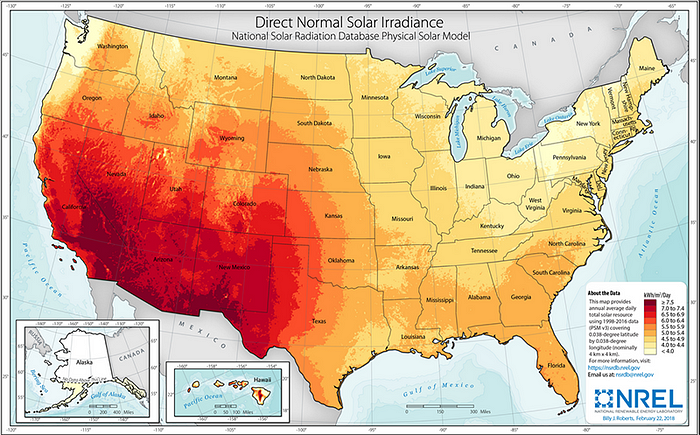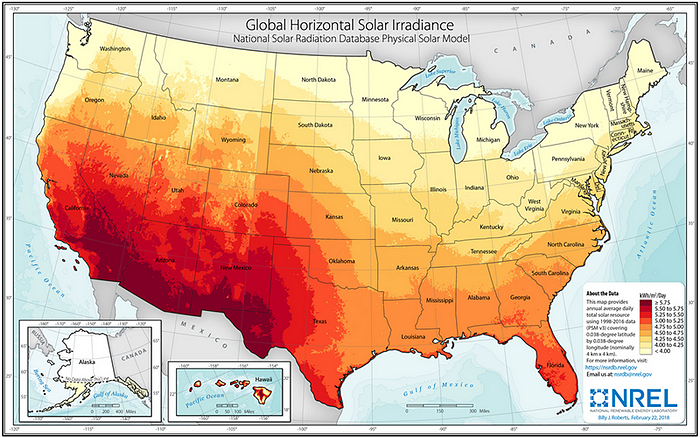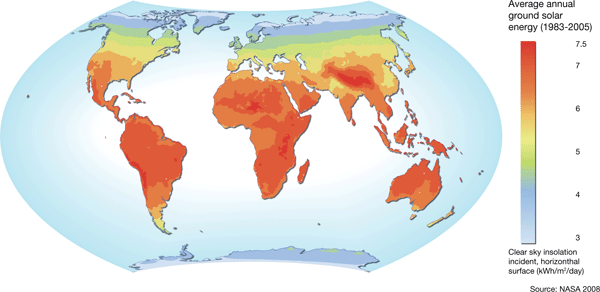Solar energy is sunshine
Sunshine is radiant energy from the sun. The amount of solar radiation, or solar energy, that the earth receives each day is many times greater than the total amount of all energy that people consume each day. However, on the earth’s surface, solar energy is a variable and intermittent energy source. Nevertheless, use of solar energy, especially for electricity generation, has increased significantly in the United States and around the world in the past 30 years.
Solar energy resources vary by location
The availability and intensity of solar radiation on the earth’s surface varies by time of day and location. In general, the intensity of solar radiation at any location is greatest when the sun is at its highest apparent position in the sky — at solar noon — on clear, cloudless days.
Latitude, climate, and weather patterns are major factors that affect insolation — the amount of solar radiation received on a given surface area during a specific amount of time. Locations in lower latitudes and in arid climates generally receive higher amounts of insolation than other locations. Clouds, dust, volcanic ash, and pollution in the atmosphere affect insolation levels at the surface. Buildings, trees, and mountains may shade a location during different times of the day in different months of the year. Seasonal (monthly) variations in solar resources increase with increasing distance from the earth’s equator.
The type of solar collector also determines the type of solar radiation and level of insolation that a solar collector receives. Concentrating solar collector systems, such as those used in solar thermal-electric power plants, require direct solar radiation, which is generally greater in arid regions with few cloudy days. Flat-plate solar thermal and photovoltaic (PV) collectors are able to use global solar radiation, which includes diffuse (scattered) and direct solar radiation. Learn more about solar radiation.
In general, a solar energy collector with a tracking system will have higher levels of daily and annual insolation than a solar collector in a fixed position. Learn more about PV collector tilt angles and PV collector tracking systems.
The two maps below show U.S. average annual solar radiation in kilowatthours (kWh) per square meter per day (kWh/m2/d) for direct normal irradiance (DNI) used by concentrating solar energy collectors and global horizontal irradiance (GHI) used by flat-plate solar collectors. The world map below shows average daily global solar radiation on a horizontal flat surface.

Source: National Renewable Energy Laboratory, U.S. Department of Energy

Source: National Renewable Energy Laboratory, U.S. Department of Energy

World map of solar resources
Source: United Nations Environment Programme (UNEP), NASA Surface meteorology and Solar Energy (SSE), 2008.
Where solar energy is used
Insolation levels are important for the technical and economic performance of solar energy systems. The availability of financial and other incentives for solar energy are also major factors that influence where solar energy systems are installed. Net metering has been especially important in encouraging the installation of PV systems on homes and businesses.
Total solar energy use in the United States increased from about 0.06 trillion British thermal units (Btu) in 1984 to about 1,246 trillion Btu (or about 1.2 quadrillion Btu) in 2020. Solar electricity generation accounted for about 95% all of total solar energy use in 2020 and direct use of solar energy for heating accounted for about 5%.
Total U.S. solar electricity generation increased from about 5 million kWh in 1984 (nearly all from solar thermal-electric power plants), to about 133 billion kWh in 2020, of which 66% was from utility-scale PV power plants, 31% was from distributed/small-scale PV systems, and 2% was from solar thermal-electric power plants. Utility-scale power plants have at least one megawatt (MW) of electricity generation capacity and small-scale systems have less than one MW generation capacity.
The maps below show total annual solar electricity generation in each state from utility-scale solar power plants and estimated electricity generation from small-scale PV systems. Most small-scale PV systems are installed on buildings. Residential sector small-scale PV systems accounted for 61% of total small-scale PV electricity generation in 2020.
Utility-scale solar electricitygeneration by state,
District of Columbia
0.0180 billion kWh
Map of unspecified region with 2 data series.
Chart graphic.
Small-scale solar photovoltaicelectricity generation by state,2020AKAKALALARARAZAZCACACOCOCTCTDCDCDEDEFLFLGAGAHIHIIAIAIDIDILILININKSKSKYKYLALAMAMAMDMDMEMEMIMIMNMNMOMOMSMSMTMTNCNCNDNDNENENHNHNJNJNMNMNVNVNYNYOHOHOKOKORORPAPARIRISCSCSDSDTNTNTXTXUTUTVAVAVTVTWAWAWIWIWVWVWYWY< 0.10.1–0.91.0–1.92.0–9.910.0–20.0< 0.10.1–0.91.0–1.92.0–9.910.0–20.0billion kWhSource: U.S. Energy Information Administration, ElectricPower Monthly, February 2021, preliminary data
Maine
0.0890 billion kWh
According to EIA’s International Energy Statistics, in 1990, 11 countries generated about 0.4 billion kWh of total solar electricity generation, and in 2019, 218 countries and U.S. territories generated about 699 billion kWh. The top five producers of solar electricity and their percentage shares of world total solar electricity generation in 2019 were:
- China–32%
- United States–15%
- Japan–11%
- India–7%
- Germany–6%
- Also in Solar explained
- Solar
- Photovoltaics and electricity
- Where solar is found and used
- Solar thermal power plants
- Solar thermal collectors
- Solar energy and the environment
- Learn more
- U.S. Department of Energy Solar Energy Technologies Office
- Solar energy basics
- Solar resource information
- Solar resource glossary
- Monthly Energy Review — Renewable Energy
- Annual Energy Outlook
- Articles on solar energy
- Also on Energy Explained
- U.S. energy facts
- Electricity in the United States
- Renewable energy types and usages
- Renewable energy incentives
- Frequently asked questions
- What is the difference between electricity generation capacity and electricity generation?
- How much of U.S. energy consumption and electricity generation comes from renewable energy sources?
- How much of world energy consumption and production is from renewable energy?
- About EIA
- Open Data
- Press Room
- Careers
- Contact Us
U.S. Energy Information Administration
1000 Independence Ave., SW
Washington, DC 20585
